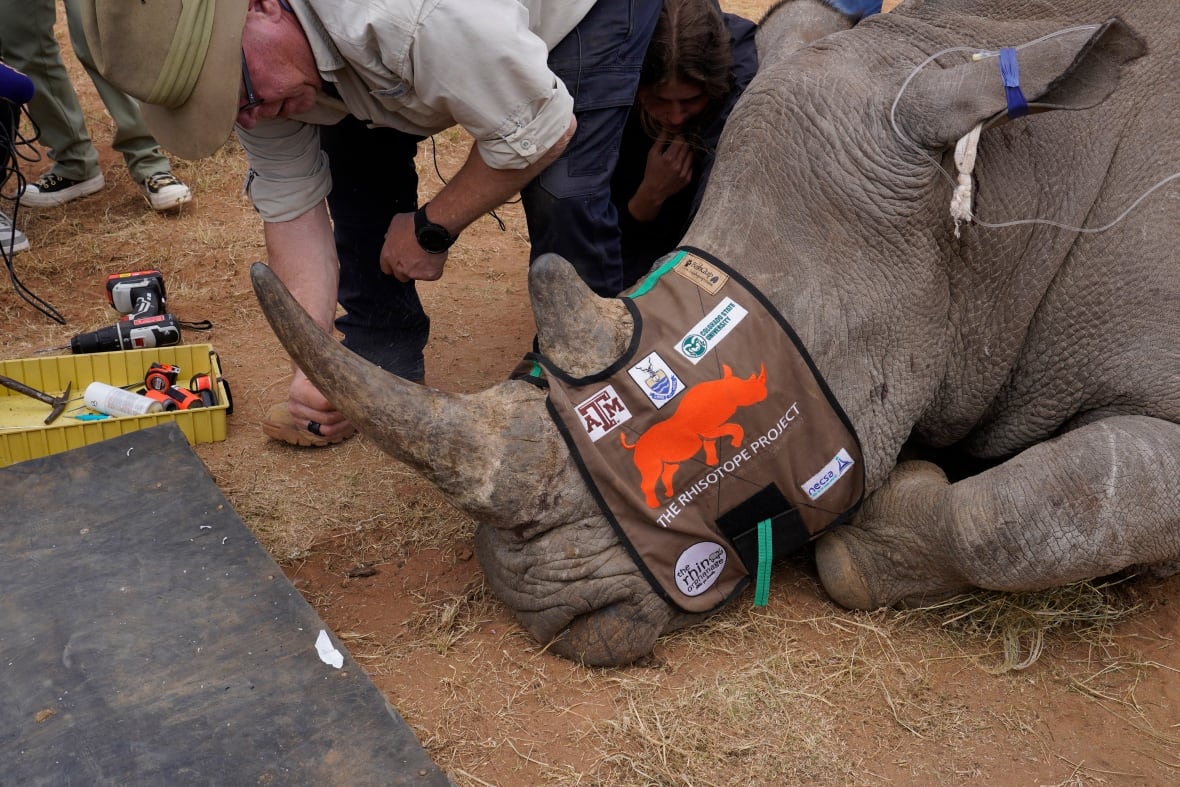
Conservationists are giving rhinos radioactive horns to save them from poachers
Published: 2025-08-02 00:44:25 | Views: 13
As It HappensConservationists are giving rhinos radioactive horns to save them from poachers
Injecting radioactive isotopes into the horn of a living rhinoceros is a lot easier than it sounds, says James Larkin.
"You basically drill a hole in the horn, put a carefully selected radio isotope into the horn in a couple of places, then you seal it up, you reverse the tranquillizer, and you send the rhino on its way for the next five years," he told As It Happens guest host Paul Hunter.
"It's easy. All done and dusted in a couple of minutes."
Larkin is the chief science officer at the Rhisotope Project, which aims to protect South Africa's critically endangered rhinos by making their horns radioactive.
The doses, he says, are too weak to pose any risk to the animals, but strong enough to set off nuclear security system alarms at international border crossings. The goal is to deter people from poaching rhinos, and catch those who do.
Scientists who are not involved in the project welcome the innovative effort to protect the critically endangered animals, but stress that this work alone not enough to save them.
Low doses proved safe in trial
The Rhisotope Project project is a collaboration between nuclear energy officials and conservationist scientists, in partnership with the International Atomic Energy Agency (IAEA), and South Africa's University of the Witwatersrand, where Larkin is the director of the Radiation and Health Physics Unit.
"Having seen enough of those videos of animals being mutilated … it came to me that, hey, maybe I could do something about it using my background," he said.
First, he says, they had to make sure that it worked, and was safe for the rhinos.
So over the last six years, he and his colleagues have been testing the idea, first in the lab with computational modelling to determine the safest effective dose, and later in the field, where they injected 20 black and white rhinos at the Rhino Orphanage in South Africa's Limpopo province.
Followup studies on the rhinos, he says, showed no negative effects from the radiation, which he says is the human equivalent of getting three CT scans a year.
"No, it will not harm the animals and, no, they won't glow in the dark." Larkin said.

The radiation is, however, strong enough to set off radiation detectors at airports and other border crossings.
"Over the years, because of the threat of nuclear terrorism, these detectors have been installed around the world at harbours, airports and places like that to stop the illicit movement of radioactive material," Larkin said.
"So we're standing on the shoulders of that in many ways. The systems are there. The operating procedures are there. So we've just merely said: let's use that to help reduce the trafficking of rhino horn."
The goal, he says, is not only to catch people trafficking the horns, but to deter other poachers from even bothering to try.
"By using already installed nuclear security infrastructure in novel ways, we can help protect one of the world's most iconic and endangered species."
IAEA director general Mariano Grossi said the project shows how nuclear science "can be used in new ways to address global challenges."
"By using already installed nuclear security infrastructure in novel ways, we can help protect one of the world's most iconic and endangered species," he said in a United Nations press release.
It's one of several novel approaches to rhino conservation in recent years. A study published last year also showed that de-horning rhinos reduced poaching by 78 per cent over a seven-year period on eight reserves.
De-horning doesn't affect the animals' health or ability to procreate, but a 2023 study found it may impact their behaviour, causing them to socialize less and reduce the size of their home ranges.
Hundreds of rhinos killed every year
The Rhisotope Project has injected five rhinos so far outside the original trial group, but are hoping their work will lead to mass injections across the country. They're encouraging private wildlife park owners and national conservation authorities to sign on.
The International Union for Conservation of Nature estimates that the global rhino population stood at around 500,000 at the beginning of the 20th century but has now declined to around 27,000 due to continued demand for rhino horns on the black market.
South Africa has the largest population of rhinos with an estimated 16,000 but the country experiences high levels of poaching with about 500 rhinos killed for their horns every year.
Larkin says a rhino horn can fetch as much as $60,000 US ($82,000 Cdn) on the black market. It's sometimes used in traditional medicines in Asian countries, but Larkin says their main purpose is as a symbol of wealth and status.
"Nowadays, it's being able to show off to your friends and business colleagues, to be honest," he said.
Berger says he hopes this method can be adapted to protect other highly poached animals, and says he's already in talks with conservationists who work to protect elephants, which are poached for their horns, and pangolins, which are hunted for their scales.

Joel Berger, a wildlife ecologist at Colorado State University who is not involved in the project, welcomed the initiative.
"Having studied black and white rhinos in southern Africa and watching the gruesome toll of poaching, now — some 30 years later — it's incredibly exciting that new technologies are being tested to try to thwart the illicit trade," Berger told CBC in an email.
"The use of radioactive isotopes implanted in horns to enhance detectability of smuggled horns across borders offers hope to capture greedy marketers of the world's innocent icons."
Still, he says, it's not enough on its own to save the rhinos. Authorities also need to crack down on the criminal networks that keep the rhino horn trade alive, he said.
Source link







